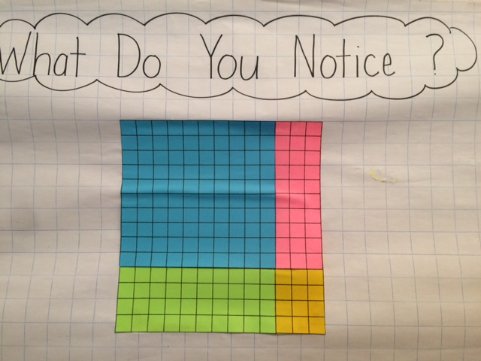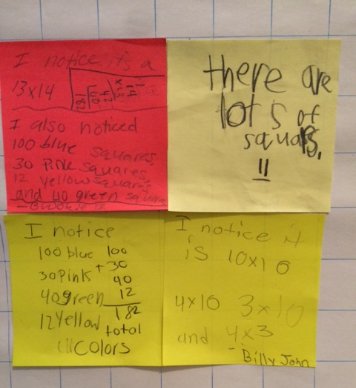
Primary students (K-2): geometry, counting, repeated addition
Intermediate students (3-5): geometry, single- and double-digit multiplication, distributive property of multiplication, array model of multiplication
What's really cool about multiplication is that no matter what two numbers are multiplied together, geometrically the result creates a rectangular array*. That's because multiplication is simply repeated addition. The color coding of the poster array helps students visualize this repeated addition. For example, the pink rectangle represents 3 + 3 + 3 + 3 + 3 and so on. But equally clear is that the problem 14 x 13 is 14 rows of 13: 13 + 13 + 13 + 13 + 13...
The other really cool thing is that we can break that visual representation down into partial products. For example, the array on the poster represents the problem 14 x 13. Using partial products to solve the problem would look like: Each one of the partial products is clearly visible in the array model. When we break apart the factors into addends (10 + 4 and 10 + 3) and then multiply, we're using the distributive property of multiplication.
Each one of the partial products is clearly visible in the array model. When we break apart the factors into addends (10 + 4 and 10 + 3) and then multiply, we're using the distributive property of multiplication.
This array is a great example of how the different topics in math can help support each other...in our case how geometry can show how numbers work.
*A rectangular array is made up of squares laid out in rows and columns.

"I noticed it's a 13x14. I also noticed 100 blue squares, 30 pink squares, 12 yellow squares, and 40 green squares."
"There are lots of squares - 11."
"I notice 100 blue, 30 pink, 40 green, 12 yellow: 100+30+40+12=182 total colors (colored squares)"
"I notice it is 10x16, 4x10, 3x10, 4x3."